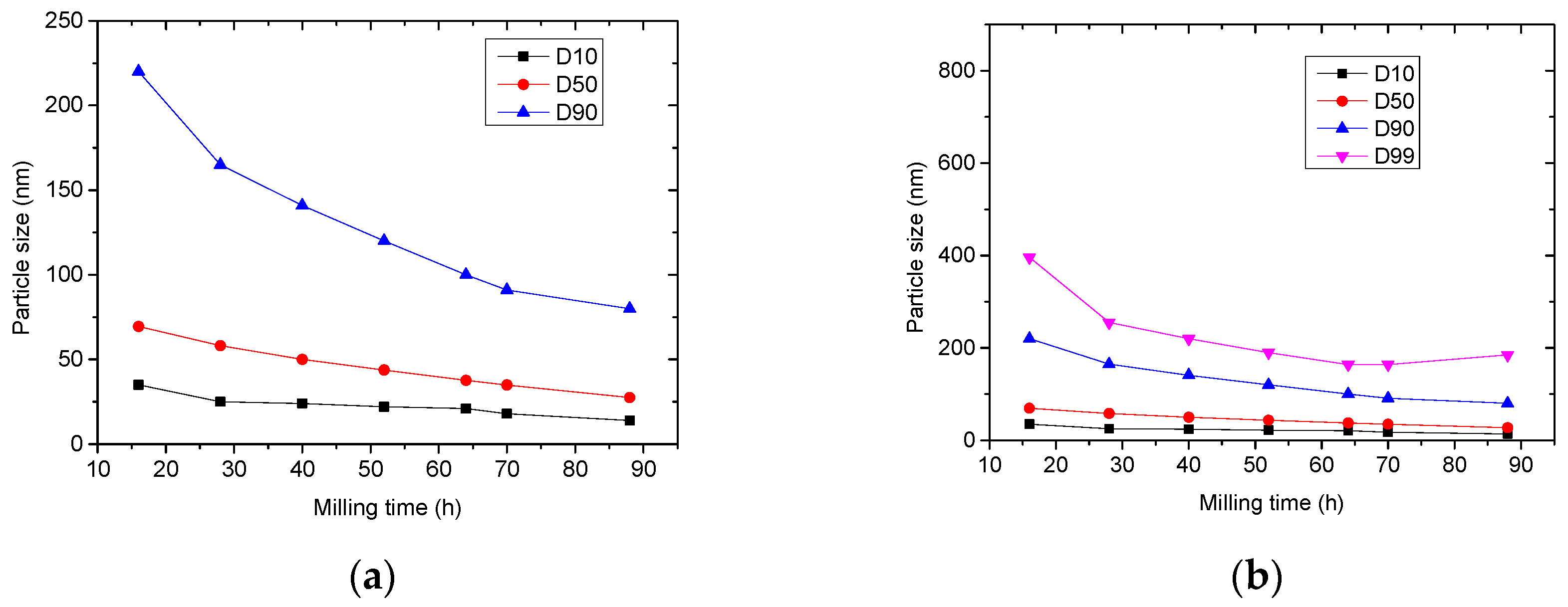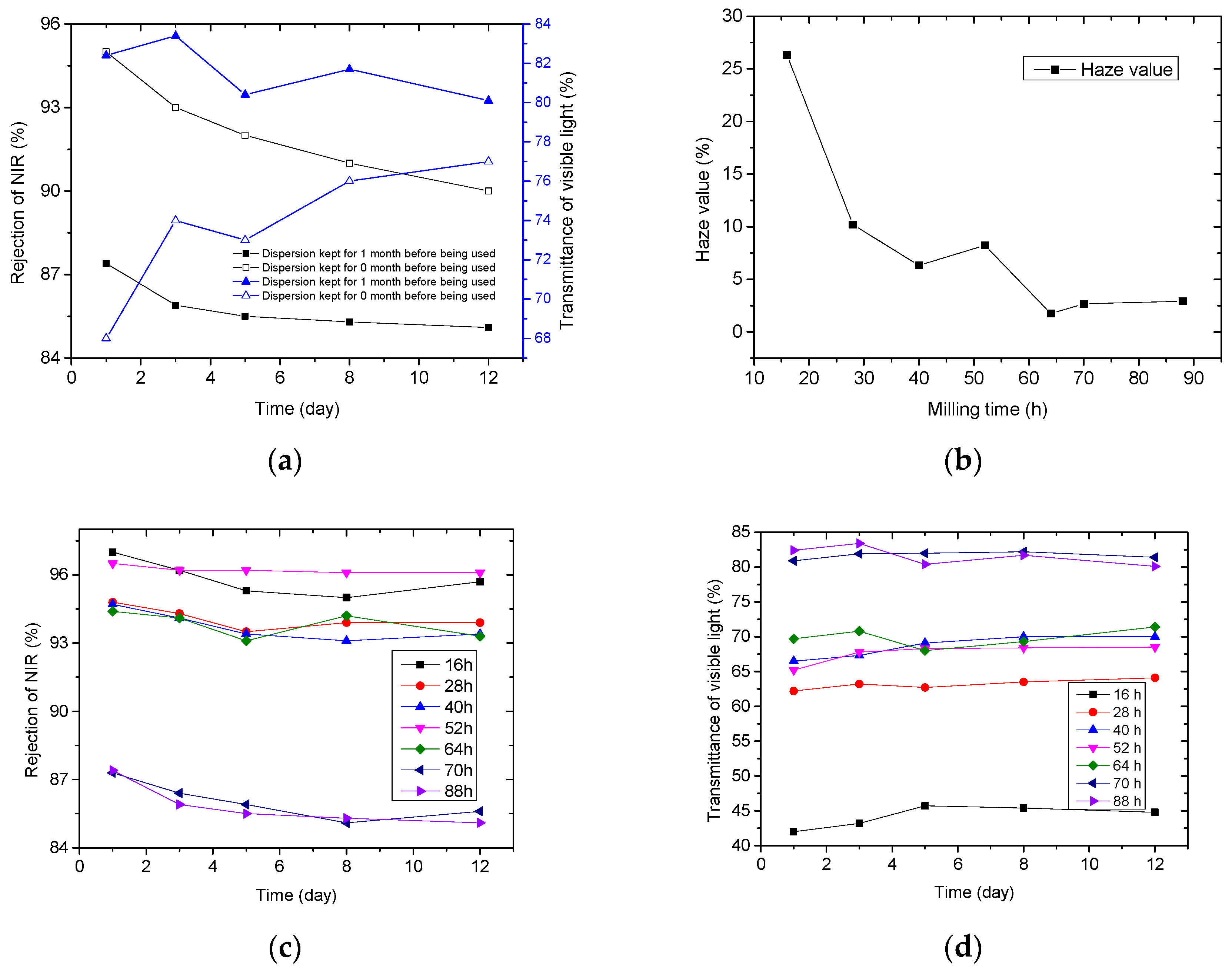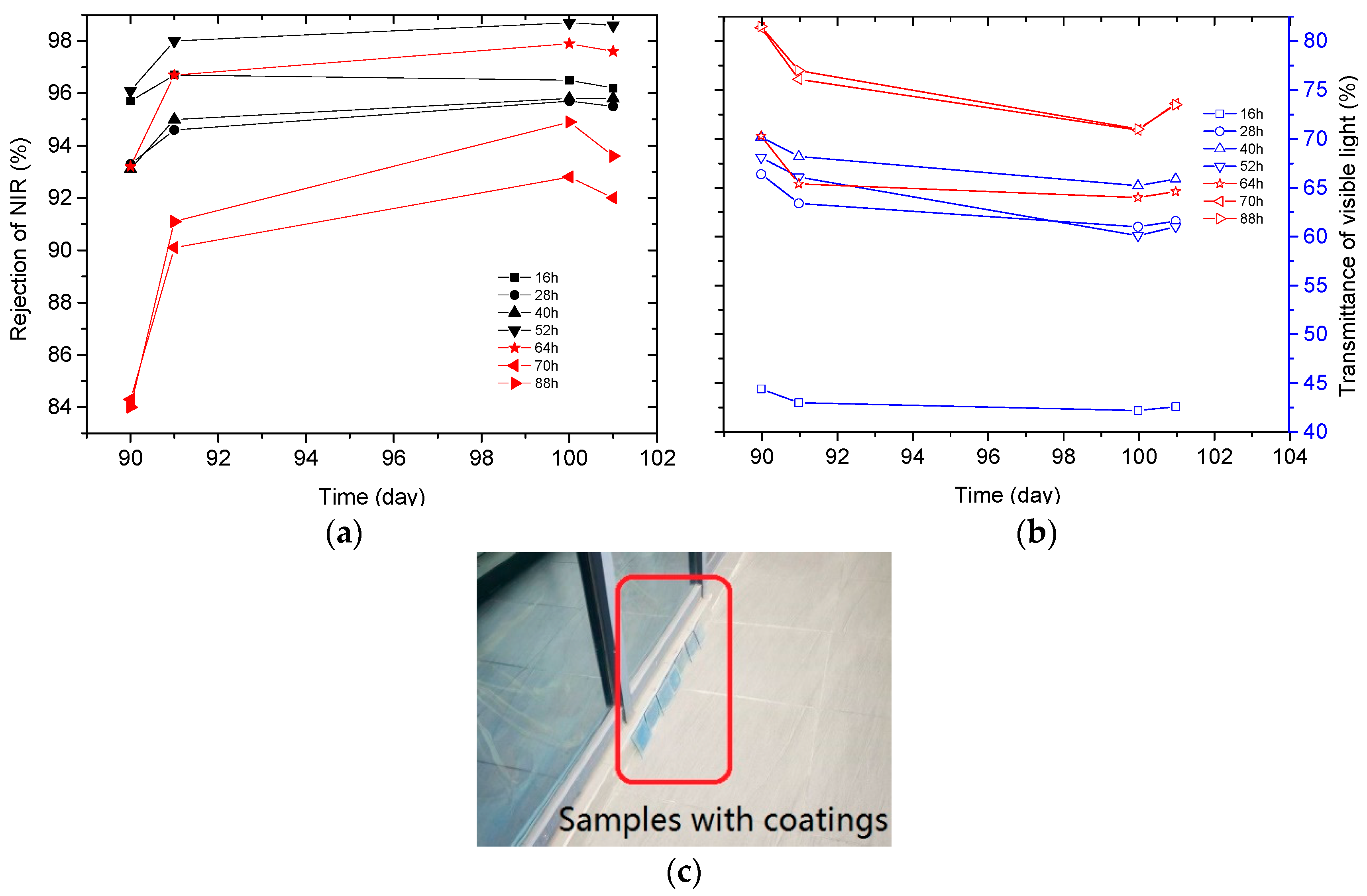A Study of the Optical Properties and Stability of Cs0.33WO3 with Different Particle Sizes for Energy-Efficient Window Films in Building Glazing
Abstract
:1. Introduction
2. Materials and Experiments
2.1. Materials
2.2. Synthesis of CWO Nanopowders
2.3. Preparation of Nano CWO Dispersions
2.4. Characterization
3. Results and Discussion
3.1. Particle Size Analysis
3.2. Optical Data and Stability of CWO Nanoparticles
4. Conclusions
Author Contributions
Funding
Data Availability Statement
Conflicts of Interest
References
- Global CO2 Emissions and China’s Challenges. Available online: http://english.scio.gov.cn/in-depth/2021-05/08/content_77475496.htm (accessed on 8 May 2021).
- Misiopeckia, C.; Bouquinb, M.; Gustavsenc, A.; Jelle, B.P. Thermal modeling and investigation of the most energy-efficient window position. Energy Build. 2018, 158, 1079–1086. [Google Scholar] [CrossRef]
- Luamsri, N.; Wootthikanokkhan, J.; Wimolmala, E.; Rakkwamsuk, P.; Sangkhun, W. Spectral selectivity and stability of energy-saving window films based on poly(vinyl chloride) reinforced with ATO nanoparticles. Polym. Test. 2019, 80, 106–157. [Google Scholar] [CrossRef]
- Qu, J.; Song, J.; Qin, J.; Song, Z.; Zhang, W.; Shi, Y.; Zhang, T.; Zhang, H.; Zhang, R.; He, Z.; et al. Transparent thermal insulation coatings for energy efficient glasswindows and curtain walls. Energy Build. 2014, 77, 1–10. [Google Scholar] [CrossRef]
- Goebbert, C.; Nonninger, R.; Aegerter, M.A.; Schmidt, H. Wet chemical deposition of ATO and ITO coatings using crystalline nanoparticles redispersable in solutions. Thin Solid Film 1999, 351, 79–84. [Google Scholar] [CrossRef]
- Li, N.; Meng, Q.; Zhang, N. Dispersion stabilization of antimony-doped tin oxide (ATO) nanoparticles used for energy-efficient glass coating. Particuology 2014, 17, 49–53. [Google Scholar] [CrossRef]
- Xiao, L.; Su, Y.; Qiu, W.; Liu, Y.; Ran, J.; Wu, J.; Lu, F.; Shao, F.; Tang, D.; Peng, P. Solar radiation shielding properties of transparent LaB6 filters through experimental and first-principles calculation methods. Ceram. Int. 2016, 42, 14278–14281. [Google Scholar] [CrossRef]
- Li, G.; Guo, C.; Yan, M.; Liu, S. CsxWO3 nanorods: Realization of full-spectrum-responsive photocatalytic activities from UV, visible to near-infrared region. Appl. Catal. B Environ. 2016, 183, 142–148. [Google Scholar] [CrossRef]
- Wu, X.; Wang, J.; Zhang, G.; Katsumata, K.-I.; Yanagisawa, K.; Sato, T.; Yin, S. Series of MxWO3/ZnO (M = K, Rb, NH4) nanocomposites: Combination of energy saving and environmental decontamination functions. Appl. Catal. B Environ. 2017, 201, 128–136. [Google Scholar] [CrossRef]
- Kim, J.Y.; Yoon, H.J.; Jeong, S.Y.; Lee, S.; Shin, G.J.; Choi, K.H. Effect of CsxWO3 Nanoparticles Content and Atomic Ratio for Near Infrared Cut-off Characteristics. IPCBEE 2012, 46, 38–42. [Google Scholar]
- Yang, G.; Qi, Y.; Hu, D.; Wang, H.; Chena, H.; Zhang, L.; Cao, C.; Liu, B.; Xia, F.; Gao, Y. Sodium tungsten bronze (NaxWO3)-doped near-infrared-shielding bulk glasses for energy-saving applications. J. Mater. Sci. Technol. 2021, 89, 150–157. [Google Scholar] [CrossRef]
- Tong, Z.; Li, N.; Lv, H.; Tian, Y.; Qu, H.; Zhang, X.; Zhao, J.; Li, Y. Annealing synthesis of corallineV2O5 nanorod architecture for multicolor energy-efficient electrochromic device. Sol. Energy Mater. Sol. Cells 2016, 146, 135–143. [Google Scholar] [CrossRef]
- Wang, S.; Liu, M.; Kong, L.; Long, Y.; Jiang, X.; Yu, A. Recent progress in VO2 smart coatings: Strategies to improve the thermochromic properties. Prog. Mater. Sci. 2016, 81, 1–54. [Google Scholar] [CrossRef]
- Eshaghi, A.; Graeli, A. Optical and electrical properties of indium tin oxide (ITO) nanostructured thin films deposited on polycarbonate substrates “thickness effect”. Optik 2014, 125, 1478–1481. [Google Scholar] [CrossRef]
- Yao, Y.; Zhang, L.; Chen, Z.; Cao, C.; Gao, Y.; Luo, H. Synthesis of CsxWO3 nanoparticles and their NIR shielding properties. Ceram. Int. 2018, 44, 13469–13475. [Google Scholar] [CrossRef]
- Song, X.; Liu, J.; Shi, F.; Fan, C.; Ran, S.; Zhang, H.; Zou, Z. Facile fabrication of KmCsnWO3 with greatly improved near-infrared shielding efficiency based on W5+-induced small polaron and local surface plasmon resonance (LSPR) modulation. Sol. Energy Mater. Sol. Cells 2020, 218, 110769. [Google Scholar] [CrossRef]
- Choi, J.; Moon, K.; Kang, I.; Kim, S.; Yoo, P.J.; Oh, K.W.; Park, J. Preparation of quaternary tungsten bronze nanoparticles by a thermal decomposition of ammonium metatungstate with oleylamine. Chem. Eng. J. 2015, 281, 236–242. [Google Scholar] [CrossRef]
- Cai, L.; Wu, X.; Gao, Q.; Fan, Y. Effect of morphology on the near infrared shielding property and thermal performance of K0.3WO3 blue pigments for smart window applications. Dye. Pigment. 2018, 156, 33–38. [Google Scholar] [CrossRef]
- Zhang, H.; Liu, J.; Shi, F.; Jiang, S.; Song, X.; Wasim, M.; Song, X.; Ma, J. Controlling the growth of hexagonal CsxWO3 nanorods by Li+-doping to further improve its near infrared shielding performance. Sol. Energy Mater. Sol. Cells 2022, 238, 111612. [Google Scholar] [CrossRef]
- Ran, S.; Liu, J.; Shi, F.; Fan, C.; Chen, B.; Zhang, H.; Yu, L.; Liu, S.-H. Greatly improved heat-shielding performance of KxWO3 by trace Pt doping for energy-saving window glass applications. Sol. Energy Mater. Sol. Cells 2018, 174, 342–350. [Google Scholar] [CrossRef]
- Adachi, K.; Ota, Y.; Tanaka, H.; Okada, M.; Oshimura, N.; Tofuku, A. Chromatic instabilities in cesium-doped tungsten bronze nanoparticles. J. Appl. Phys. 2013, 114, 194304. [Google Scholar] [CrossRef]
- Nakakura, S.; Machida, K.; Tanabe, E.; Adachi, K.; Ogi, T. Improved photochromic stability in less deficient cesium tungsten bronze nanoparticles. Adv. Powder Technol. 2020, 31, 702–707. [Google Scholar] [CrossRef]
- Lee, W.H.; Hwang, H.; Moon, K.; Shin, K.; Han, J.H.; Um, S.H.; Park, J.; Cho, J.H. Increased Environmental Stability of a Tungsten Bronze NIR-absorbing Window. Fibers Polym. 2013, 14, 2077–2082. [Google Scholar] [CrossRef]
- Chena, Y.; Zeng, X.; Zhou, Y.; Li, R.; Yao, H.; Cao, X.; Jin, P. Core-shell structured CsxWO3@ZnO with excellent stability and high performance on near-infrared shielding. Ceram. Int. 2018, 44, 2738–2744. [Google Scholar] [CrossRef]





Disclaimer/Publisher’s Note: The statements, opinions and data contained in all publications are solely those of the individual author(s) and contributor(s) and not of MDPI and/or the editor(s). MDPI and/or the editor(s) disclaim responsibility for any injury to people or property resulting from any ideas, methods, instructions or products referred to in the content. |
© 2024 by the authors. Licensee MDPI, Basel, Switzerland. This article is an open access article distributed under the terms and conditions of the Creative Commons Attribution (CC BY) license (https://creativecommons.org/licenses/by/4.0/).
Share and Cite
Li, N.; Meng, Q.; Zhao, L.; Zhang, N.; Wang, P.; Lu, S. A Study of the Optical Properties and Stability of Cs0.33WO3 with Different Particle Sizes for Energy-Efficient Window Films in Building Glazing. Buildings 2024, 14, 3133. https://doi.org/10.3390/buildings14103133
Li N, Meng Q, Zhao L, Zhang N, Wang P, Lu S. A Study of the Optical Properties and Stability of Cs0.33WO3 with Different Particle Sizes for Energy-Efficient Window Films in Building Glazing. Buildings. 2024; 14(10):3133. https://doi.org/10.3390/buildings14103133
Chicago/Turabian StyleLi, Ning, Qinglin Meng, Lihua Zhao, Nan Zhang, Pin Wang, and Sumei Lu. 2024. "A Study of the Optical Properties and Stability of Cs0.33WO3 with Different Particle Sizes for Energy-Efficient Window Films in Building Glazing" Buildings 14, no. 10: 3133. https://doi.org/10.3390/buildings14103133





